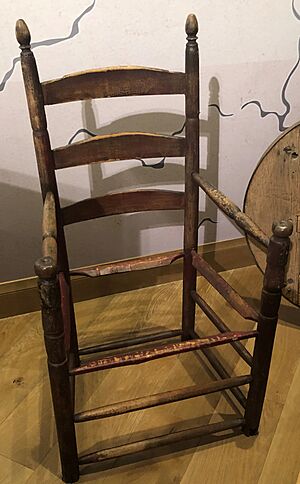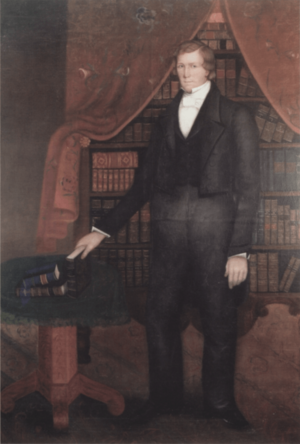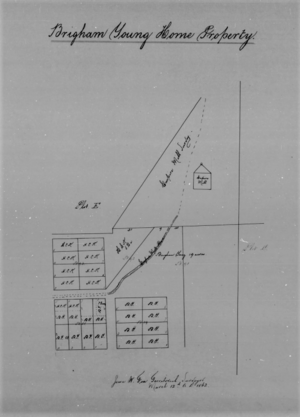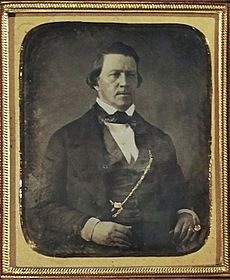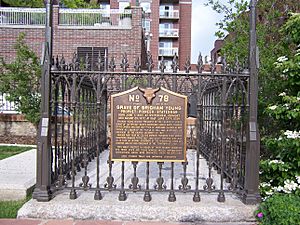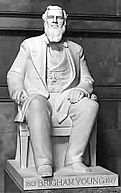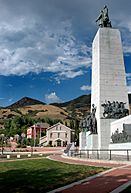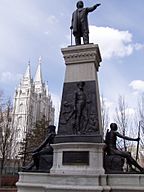Brigham Young facts for kids
Quick facts for kids Brigham Young |
|
|---|---|
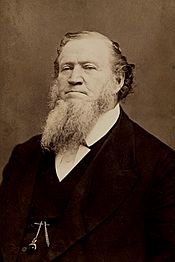
Brigham Young c. 1870
|
|
| 2nd President of the Church of Jesus Christ of Latter-day Saints | |
| December 27, 1847 – August 29, 1877 | |
| Predecessor | Joseph Smith |
| Successor | John Taylor |
| President of the Quorum of the Twelve Apostles | |
| April 14, 1840 – December 27, 1847 | |
| Predecessor | Thomas B. Marsh |
| Successor | Orson Hyde |
| End reason | Became President of the Church |
| Quorum of the Twelve Apostles | |
| February 14, 1835 – December 27, 1847 | |
| Called by | Three Witnesses |
| End reason | Became President of the Church |
| LDS Church Apostle | |
| February 14, 1835 – August 29, 1877 | |
| Called by | Three Witnesses |
| Reason | Initial organization of Quorum of the Twelve |
| Reorganization at end of term |
No apostles immediately ordained |
| 1st Governor of Utah Territory | |
| In office | |
| February 3, 1851 – April 12, 1858 | |
| Predecessor | Position established |
| Successor | Alfred Cumming |
| Personal details | |
| Born | June 1, 1801 Whitingham, Vermont, U.S. |
| Died | August 29, 1877 (aged 76) Salt Lake City, Utah Territory, U.S. |
| Cause of death | Ruptured appendix |
| Resting place | Brigham Young Cemetery 40°46′13″N 111°53′08″W / 40.7703°N 111.8856°W |
| Spouse(s) | See List of Brigham Young's wives |
| Children | 56 |
| Signature | |
Brigham Young (June 1, 1801 – August 29, 1877) was an important American religious leader and politician. He was the second president of The Church of Jesus Christ of Latter-day Saints (LDS Church). He served from 1847 until his death in 1877.
As church president, Young led his followers, known as Mormon pioneers, on a long journey west. They traveled from Nauvoo, Illinois, to the Salt Lake Valley. He founded Salt Lake City and became the first governor of the Utah Territory. Young also helped start schools that later became the University of Utah and Brigham Young University. He also led the church during the Utah War against the United States.
Contents
Early Life of Brigham Young
Brigham Young was born on June 1, 1801, in Whitingham, Vermont. He was the ninth child of John and Abigail Young. His father was a farmer. When Brigham was three, his family moved to upstate New York. They settled in Chenango County.
Young did not go to school much. However, his mother taught him how to read and write. At age twelve, he moved with his parents to Genoa, New York. His mother died in 1815. After her death, he moved with his father to Tyrone, New York.
Young's father remarried and sent Brigham to learn a trade. Young moved to Auburn, New York. There, he became an apprentice to John C. Jeffries. He worked as a carpenter, glazier, and painter.
After his apprenticeship ended, Young moved to Port Byron. He married Miriam Angeline Works in October 1824. Their daughter, Elizabeth, was born in 1825.
Young joined the Reformed Methodist Church in 1824. He insisted on being baptized by immersion. In 1828, his family moved to Mendon, New York. There, Young met Heber C. Kimball, who became an early member of the LDS Church. Young worked as a carpenter and built a saw mill.
Joining The Church of Christ
By 1828, Young had left the Methodist church. He was looking for a church with true authority from Jesus Christ. Around 1830, he learned about the Book of Mormon. He did not immediately accept it.
In 1831, five missionaries from the Latter Day Saint movement came to Mendon. They taught about spiritual gifts like speaking in tongues. Young joined the Church of Christ on April 9, 1832. He was baptized by Eleazer Miller. Many of Young's family members also joined the church.
After joining, Young and Heber C. Kimball did missionary work in western New York. Young's wife, Miriam, died. Vilate Kimball cared for Young's children. Young, Heber, and Joseph Young visited Joseph Smith in Kirtland, Ohio. During this visit, Brigham spoke in a language Smith called the "Adamic language".
Young continued to preach. In 1833, he moved with his two daughters to Kirtland, Ohio. He married Mary Ann Angell in February 1834. In May 1834, Young joined Zion's Camp. He traveled to Missouri and returned to Kirtland in August. He worked as a carpenter and painter. He also worked on the Kirtland Temple.
Church Leadership and Service
On February 14, 1835, Brigham Young was chosen as a member of the Quorum of the Twelve Apostles. He went on missions to Pennsylvania and New York. He helped finish the Kirtland temple. He spoke in tongues at its dedication in 1836.
Young went on more missions to New York and New England. He returned to Kirtland. In December 1837, he had to leave Kirtland because of problems within the church. He moved to Far West, Missouri in 1838. His family and other church members joined him there.
Young became the oldest member of the Quorum of the Twelve Apostles after David Patten died. Joseph Smith appointed Young as a leader in Missouri.
Under Young's guidance, the apostles organized the move of Latter Day Saints from Missouri to Illinois in 1838. Young also served a year-long mission in the United Kingdom. He was good at organizing the church's work. Under his leadership, members in the United Kingdom started publishing Millennial Star and a hymnal.
Young also held leadership roles in Nauvoo, Illinois. He joined the Nauvoo city council in 1841. He oversaw the first baptisms for the dead in the unfinished Nauvoo temple. Young and the other apostles directed missionary work. They also helped new converts move to Nauvoo.
In 1844, Young traveled east to gather support for Joseph Smith's presidential campaign. In June 1844, while Young was away, Joseph Smith was killed by a mob. Young learned about this in early July.
Several people wanted to lead the church after Smith's death. Sidney Rigdon argued that he should be the church's guardian. Young argued that the Twelve Apostles should lead. The majority of church members voted for the Quorum of the Twelve to lead. Many of Young's followers said that when he spoke, he looked and sounded like Joseph Smith. They believed this was a sign from God.
Young became the church's acting president. He led the church as president of the Quorum of the Twelve until December 5, 1847. Then, a new First Presidency was formed with Young as president of the church. Church members supported this decision on December 27, 1847.
Before leaving Nauvoo, Young focused on finishing the Nauvoo temple. After the outside was done in December 1845, members received temple blessings day and night. Young led many of these sessions. About 5,000 members received blessings.
In January 1845, Nauvoo's city charter was removed. This left church members without their own courts, police, or militia. They were open to attacks. Young told victims of violence to move to Nauvoo. Young made a deal with Stephen A. Douglas to lead church members out of Nauvoo in the spring for peace.
Young and other church leaders were accused of counterfeiting money in 1845. Young himself said counterfeiting was wrong. The accusations and rumors of troops stopping their move led Young to start the exodus in February 1846.
Moving West to Utah
Conflicts in Nauvoo led Young to move his group of Latter-day Saints to the Salt Lake Valley. This area was then part of Mexico. Young organized the journey for the Mormon pioneers. They traveled to Winter Quarters, Nebraska, in 1846. Then they continued to the Salt Lake Valley.
By the time Young arrived, the Salt Lake Valley was under American control. This was due to the Mexican–American War. Young arrived in the Salt Lake Valley on July 24, 1847. This day is now celebrated as Pioneer Day in Utah.
Young explained why he chose the Salt Lake Valley: "God has shown me that this is the spot to locate his people, and here is where they will prosper."
One of Young's first actions was naming the city "The City of the Great Salt Lake." He organized it into blocks. Young spent a month recovering from illness. Then he returned to Winter Quarters on August 31. Young's journey was one of the largest and best organized westward treks. He made many trips to help other groups.
After three years of leading the church as the President of the Quorum of the Twelve Apostles, Young formed a new First Presidency. He was supported as the second president of the church on December 27, 1847. Young named Heber C. Kimball and Willard Richards as his counselors.
Governor of Utah Territory
The Utah Territory was created in 1850. Young was appointed its first governor and superintendent of American Indian affairs. This was done by President Millard Fillmore on February 3, 1851.
As governor, Young directed the creation of settlements. These were in what is now Utah, Idaho, Arizona, Nevada, California, and parts of Colorado and Mexico. Under his leadership, Mormons built roads, bridges, forts, and irrigation systems. They also organized a militia. Young worked to make peace with Native American tribes. He also supported the building of the First transcontinental railroad. He organized the first Utah Territorial Legislature. He made Fillmore the territory's first capital.
Young started a gold mint in 1849. It made coins from gold dust. He also created a board to start a university. This became the University of Utah. In 1849, Young arranged for a printing press to be brought to the Salt Lake Valley. This press was used to print the Deseret News newspaper.
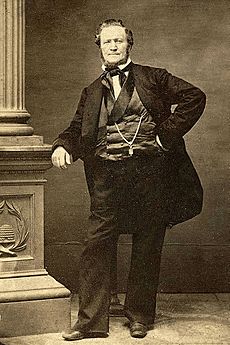
In 1851, Young and some federal officials had trouble working together. These officials left Utah. They became known as the Runaway Officials of 1851.
Young supported slavery and its expansion into Utah. He led efforts to make slavery legal and regulated in 1852. He believed slavery was a "divine institution."
In 1856, Young organized a mail service called the Brigham Young Express and Carrying Company. It carried mail and passengers between Missouri and California. In 1858, after the Utah War, he stepped down as governor. Alfred Cumming became the new governor.
Brigham Young as Church President
Brigham Young served as president of the LDS Church for 29 years. This is the longest time any president has served.
Focus on Education
As prophet and governor, Young encouraged each church leader to start a school for their group. These schools were supported by volunteers and donations. Young believed education helped build God's kingdom on earth. He felt the church had everything needed to help people learn and grow.
On October 16, 1875, Young gave buildings and land in Provo, Utah to start a school. This school was meant to be part of the University of Deseret. Young hoped it would provide a good education without harmful influences. The school later became Brigham Young Academy in 1876.
Within the church, Young reorganized the Relief Society for women in 1867. He also created organizations for young women in 1869 and young men in 1875. The Young Women's group was first called the Retrenchment Association. It aimed to help young girls avoid worldly ways.
Young also worked to improve the Deseret alphabet. This was a phonetic alphabet. It was used in some articles and books. However, it was rarely used after 1870.
Building Temples
Young was very involved in temple building. He made it a top priority as church president. He helped build the Kirtland and Nauvoo temples.
Just four days after arriving in the Salt Lake Valley, Young chose the spot for the Salt Lake Temple. He led its groundbreaking years later on April 6, 1853. During his time, Young oversaw the building of the Salt Lake Tabernacle. He also announced plans for the St. George (1871), Manti (1875), and Logan (1877) temples. He also built the Endowment House. This was a temporary temple used for church ceremonies while the Salt Lake Temple was being built.
Teachings and Beliefs
Most of Young's teachings are found in the Journal of Discourses. One section from Young is included in the LDS Church's Doctrine and Covenants.
Young taught about a practice called blood atonement. He said that for some very serious sins, Jesus's sacrifice alone might not be enough. Instead, people who committed such sins could partly make up for them by giving their own lives in a way that shed blood. The LDS Church has since said that this teaching is not part of their beliefs.
Young also taught about a restriction on priesthood for men of black African descent. This meant these men could not hold the priesthood or participate in some temple ceremonies. Young taught that this was because they were "the seed of Cain." He said this was a divine rule, not his own choice. He also taught that this restriction would one day be lifted. This policy remained until 1978. At that time, church president Spencer W. Kimball ended the restriction. The church later said it no longer supported past theories used to explain this ban.
Mormon Reformation
From 1856 to 1857, there was a period of renewed spiritual focus in the church. This was called the Mormon Reformation. It happened under Young's direction. It called for church members to become more spiritual.
Jedediah M. Grant, one of Young's counselors, traveled and preached. He encouraged Latter-day Saints to reject sin. As part of this, almost all active church members were rebaptized. This showed their renewed commitment. Young played a key role in this reformation. The Reformation ended by early 1858.
Conflicts and Challenges
After Young's pioneers arrived, their new settlements became part of the United States. Young asked the U.S. Congress to create the State of Deseret. Instead, the Compromise of 1850 created Utah Territory. Young was appointed governor.
As governor and church president, Young managed both religious and economic matters. He encouraged people to be independent. Many cities and towns in Utah were founded under his direction.
Utah War
In 1857, U.S. President James Buchanan heard reports that federal officials were being stopped in Utah. He decided to appoint a new, non-Mormon governor. He sent 2,500 soldiers with the new governor.
When Young heard about the troops, he called out his militia. They used tactics to delay the federal force. During this conflict, called the Utah War, Young kept the U.S. Army at bay for a winter. He eventually reached an agreement. He agreed to step down as governor. President Buchanan later pardoned Young.
Mountain Meadows Massacre
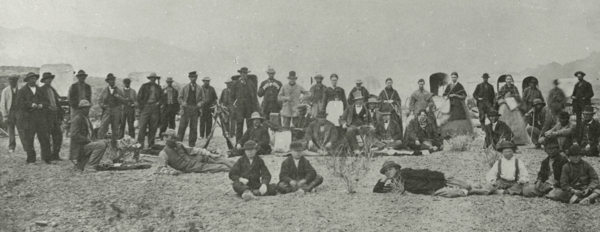
The Mountain Meadows Massacre happened in 1857. Over 120 people were killed. Young's involvement in this event is debated. Some reports say Young sent a letter telling church members to let the travelers pass safely. This letter reportedly arrived two days after the massacre.
As governor, Young had promised to protect travelers. However, many people were killed in this incident. Only children under seven survived. They were cared for by local Mormon families. A monument was later built at the site.
Death of Brigham Young
Brigham Young died in Salt Lake City on August 29, 1877. He was suffering from cholera and inflammation. It is believed he died from a ruptured appendix. His last words were "Joseph! Joseph! Joseph!", referring to Joseph Smith.
Young's funeral was held on September 2, 1877. Between 12,000 and 15,000 people attended. He is buried at the Mormon Pioneer Memorial Monument in Salt Lake City. A bronze marker was placed at his grave in 1938.
Business and Wealth
Young was involved in many businesses. These included a wagon company, a ferry, a railroad, and making lumber, wool, and iron. He was most successful in real estate. He also tried to help Mormons be self-sufficient by creating communities called the United Order of Enoch.
Young helped organize the Salt Lake Gas Works, the Salt Lake Water Works, an insurance company, a bank, and the ZCMI store. In 1873, he announced he would step down from leading these businesses. He said he wanted to focus less on "secular affairs."
When he died, Young was the wealthiest man in Utah. His personal fortune was estimated at $600,000.
Legacy and Impact
Young had many nicknames. One popular name was "American Moses" because he led his followers through a desert to a new home. His followers also called him the "Lion of the Lord" and "Brother Brigham."
He is credited with helping settle much of the American West.
There are many memorials to Young. These include a statue at Brigham Young University. There is also a marble statue in the National Statuary Hall Collection at the United States Capitol. A statue of him is also on the This is the Place Monument in Salt Lake City.
Family and Descendants
Brigham Young had many wives. Sources vary on the exact number. He was sealed to fifty-six women during his life. Some of these were "for eternity" and some "for time only." Not all of these marriages were traditional.
He had fifty-seven children with sixteen of his wives. Forty-six of his children lived to adulthood. Young built several homes in Salt Lake City to house his large family. These include the Lion House and the Beehive House. These are still famous landmarks in Salt Lake City.
At his death, nineteen of his wives had died before him. He was divorced from ten, and twenty-three survived him. Some of his wives held important positions in the church.
By 1902, 25 years after his death, The New York Times reported that Young had over 1,000 direct descendants. Some of his descendants have become church leaders, politicians, and cultural figures.
Literary Works
Many books have been published with Brigham Young's speeches and sayings.
- Teachings of President Brigham Young: Salvation for the Dead, the Spirit World, and Kindred Subjects. Seagull Press. 1922.
- Brigham Young (1925). Discourses of Brigham Young. selected by John A. Widtsoe. Deseret Book. https://archive.org/details/discoursesofbrig028407mbp.
- Young, Brigham (1952). The Best from Brigham Young: Statements from His Sermons on Religion, Education, and Community Building. selected by Alice K. Chase. Deseret Book Company.
- Manuscript History of Brigham Young, 1801–1844. Eldon J. Watson. 1969.
- Manuscript History of Brigham Young, 1846–1847. Eldon J. Watson. 1971.
- Dean C. Jessee, ed. (1974). Letters of Brigham Young to His Sons. Deseret Book Company.
- Everett L. Cooley, ed. (1980). Diary of Brigham Young, 1857. Tanner Trust Fund, University of Utah Library. http://content.lib.utah.edu/u?/tanner,2124.
- The Essential Brigham Young. Signature Books. 1992. ISBN 1-56085-010-8. http://signaturebookslibrary.org/?p=11139.
- Teachings of Presidents of the Church: Brigham Young. The Church of Jesus Christ of Latter-day Saints. 1997. LDS Church publication number 35554
- Young, Brigham (2009). Richard Van Wagoner. ed. The Complete Discourses of Brigham Young. 5. Smith-Pettit Foundation. ISBN 978-1-56085-206-3.
See also
 In Spanish: Brigham Young para niños
In Spanish: Brigham Young para niños
- Brigham Young (1940 film)
- Brigham Young Winter Home and Office
- This Is The Place Heritage Park
- Ann Eliza Young
- List of people pardoned or granted clemency by the president of the United States




